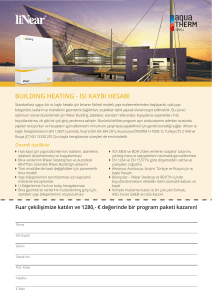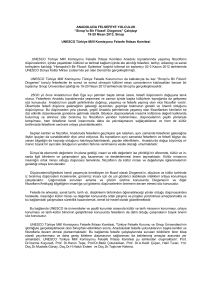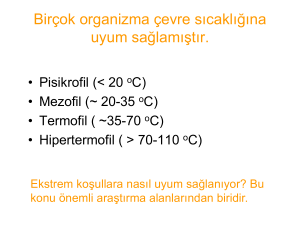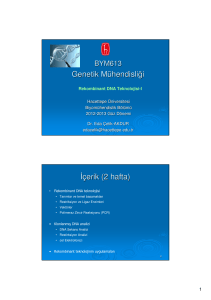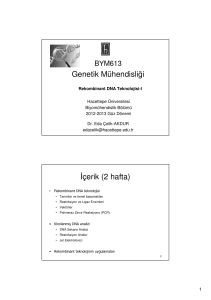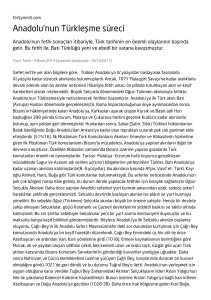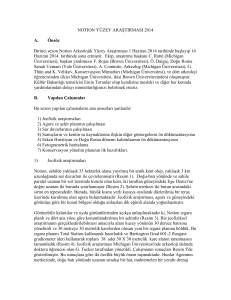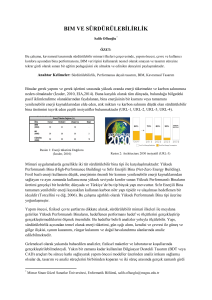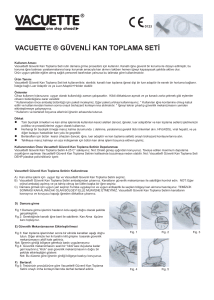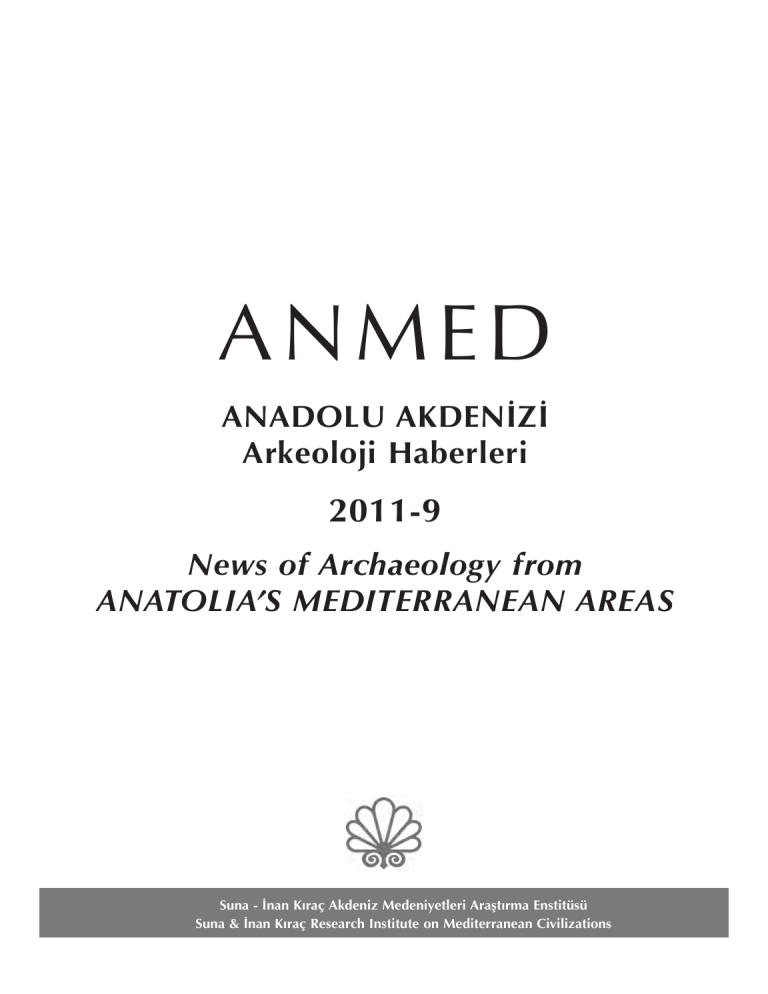
ANMED
ANADOLU AKDENİZİ
Arkeoloji Haberleri
2011-9
News of Archaeology from
ANATOLIA’S MEDITERRANEAN AREAS
Suna - İnan Kıraç Akdeniz Medeniyetleri Araştırma Enstitüsü
Suna & İnan Kıraç Research Institute on Mediterranean Civilizations
Oinoanda Arazi Çalışmaları 2010
Report on Campaign at Oinoanda in 2010
Martin BACHMANN
2010 yılında Oinoanda’da yürütülen çalışmalar* arkeolojik alana bir depo inşa edilmesine odaklandı (Res. 1).
Bu epigrafik mirasının koruma altına alınmasına yönelik
gerekli bir adımdı. Depo, hırsızlığa karşı dayanıklı çelik
konstrüksiyondan yapıldığından yazıt fragmanlarının
saklanması ve yerinde bilimsel olarak araştırılmasını
mümkün kılmaktadır. Diogenes’in felsefi yazıtlarının
Work at Oinoanda in 2010* centred on the erection of a
depot building on the archaeological site (Fig. 1). An
important step has been taken towards safeguarding the
significant epigraphic heritage. The depot is a burglarproof steel construction, making it possible for inscription fragments to be stored and scientifically studied
on site. More than 90 fragments of the philosophical
* Çalışmalar 16 Temmuz-14 Ağustos 2010 tarihleri arasında
yürütüldü. T.C. Kültür ve Turizm Bakanlığı’na araştırma izni
ve yardımları için teşekkür etmek isteriz, ayrıca Bakanlık
Temsilcisi H. E. Süel’e araştırmamıza kişisel katkıları ve desteklerinden dolayı teşekkür borçluyuz. Depo binasının inşaatı Gilbert de Botton Vakfı’ndan gelen cömert bağışlar ve
Prof. M. F. Smith ile G. Kranck’in (Steelteam), Federal Almanya Cumhuriyeti Dışişleri Bakanlığı kültürel mirası koruma
programının, J. Fraser, Prof. K. Fischer (Fischer Befestigungsysteme), Centro Internazionale per lo Studio dei Papiri Ercolanesi (CISPE), Seven Pillars of Wisdom Trust, Alman Arkeoloji Enstitüsü İstanbul Şubesi ve diğer bağımsız kişilerin katkıları ile mümkün oldu. Burada projeye yönelik aldığımız
büyük uluslararası desteğe minnettarız. Oinoanda’daki
bilimsel araştırma programı Köln Üniversitesi Stiftung Altertumskunde ve Franz Rutzen Stiftung’ın desteklediği Alman
Arkeoloji Enstitüsü ile Fritz Thyssen Stiftung’ın çalışmasıydı,
hepsine teşekkür ederiz.
Oinoanda’da 2010 yılında yapılan çalışmalarda ekipte şu
isimler yer aldı: Depo binasından sorumlu N. Koch, A. Elidenk ve M. Bachman; Oinoanda ve Diogenes yazıtı hakkında yılların emeğiyle edindiği ilk elden bilgisinin değeri bir
kez daha kanıtlanan M. F. Smith ve felsefi yazıtlar araştırmasını yürüten J. Hammerstaedt (Köln Üniversitesi); ayrıca
A. Rasselnberg (Köln Üniversitesi) ile yazıtın belgelenmesine
destek veren K. Berner (Karlsruhe Üniversitesi Uygulamalı
Bilimler); E. Laufer (Köln Üniversitesi), N. Koch (Karlsruhe
Üniversitesi), A. Zeitler (Regensburg Üniversitesi Uygulamalı
Bilimler), U. Hermann (Viyana Üniversitesi Teknoloji),
hamamlar, Bizans kilisesi ve Esplanade’nin güneyindeki kaya
oluşumunu arkeolojik belge­leyen üçü de İstanbul MSÜ’nden
Ç. Yılmazer, G. Karataş ve T. Ünlü; Diogenes fragmanları­
nın üç boyutlu taramalarını gerçekleştiren K. Berner, M.
Marzinowski ve H. Stieler (Karlsruhe Üniversitesi Uygula­
malı Bilimler); Esplanade’nin doğusundaki alanın ve kent
dışındaki jeofizik incelemesini yapan C. Klein, A. Neuber ve
* The campaign ran from 16 July to 14 August 2010. We wish
to thank the General Directorate of Cultural Heritage Preservation in Turkey for kindly issuing a permit and for their
assistance, and we thank H. E. Süel, the representative of the
Turkish government, for his personal commitment and support. Construction of the depot building was made possible
by a generous donation from the Gilbert de Botton Foundation and by substantial contributions from Prof. M. F. Smith,
G. Kranck (Steelteam), the heritage preservation programme
of the Foreign Office of the Federal Republic of Germany, J.
Fraser, Prof. K. Fischer (Fischer Befestigungsysteme), Centro
Internazionale per lo Studio dei Papiri Ercolanesi (CISPE), the
Seven Pillars of Wisdom Trust, the Istanbul Department of the
German Archaeological Institute and other individual donors.
We wish to express our appreciation here for the marvellous
international support for the project. The scientific programme of the research campaign at Oinoanda was the work
of the German Archaeological Institute and the Fritz Thyssen
Stiftung, supported by the Stiftung Altertumskunde of the
University of Cologne and the Franz Rutzen Stiftung, to
whom we also extend our thanks.
The team for the 2010 campaign at Oinoanda comprised:
N. Koch, A. Elidenk and M. Bachmann (construction of the
depot/Bauforschung); M. F. Smith (whose first-hand knowledge of Oinoanda and Diogenes’ inscription, acquired over
many years, once again proved an invaluable aid) and J.
Hammerstaedt (University of Cologne) who conducted the
research into the philosophical inscription; In Yong Song and
A. Rasselnberg (both from the University of Cologne) with K.
Berner (Karlsruhe University of Applied Sciences), who supported the documentation of inscription; E. Laufer (University of Cologne), N. Koch (University of Karlsruhe), A. Zeitler
(Regensburg University of Applied Sciences), U. Herrmann
(Vienna University of Technology), Ç. Yılmazer, G. Karataş
and T. Ünlü (all from the MSÜ, İstanbul), who carried out
the detailed architectural documentation of the baths, the
200
YÜZEY ARAŞTIRMA RAPORLARI
SURVEY REPORTS
inscriptions of Diogenes were moved to the depot
building, and further pieces, at risk from weathering
or looting, will be stored there in the coming research
seasons.
Res. 1 Depo binası
Fig. 1 Storehouse
90’dan fazla fragmanı depo binasına taşındı, yıpranma
ya da yağmalanma tehlikesi altında olan başka parçalar
da ileriki araştırma mevsimlerinde depolanacaktır.
Aynı zamanda yazıtların belgelenmesine devam edildi.
80’i aşkın yazıt fragmanı üç boyutlu taranarak bilinen
fragmanların büyük çoğunluğu belgelenmiş oldu. Yazıtın
eksik parçalarının özenli ve sistematik araştırmasında
8 fragman yeniden bulunmuş, 9 bilinmeyen fragman da
ortaya çıkarılmıştır. Mimari belgeleme çalışmasının başlıca odak noktası üç bina kompleksinin ayrıntılı olarak
kayıt altına alınması ve etkileyici Hellenistik kent surunun üç boyutlu belgelenmesiydi. Kentin gelişim evrelerinin analizini kolaylaştırmak üzere ayrıca kentsel alanın
tümünü kapsayan haritamızı gözden geçirip eksiklerini
gidermek amacıyla yeni yüzey araştırmalarına başladık.
Jeofizik inceleme Esplanade ile kent dışında kutsal alanın doğusunda kalan küçük iki inşaat terasında yoğunlaştı. Epigrafik araştırma programı nihayet felsefe dışı
yazıtları hedefleyen uzun bir arazi incelemesiyle tamamlandı; burada da birkaç yeni fragman gün ışığına çıktı.
Depo Binası Yapımı ve Diogenes Yazıtı
Fragmanlarının Muhafazası
Ören yerindeki muhafaza koşullarının sorunlu olması
nedeniyle depo inşa edilmesine karar verildi. Çözüm
olarak çelik kaplama, hırsızlığa dayanıklı bir depo
yapılması önerildi, böylece hiç olmazsa en çok hasar
görmüş ve çalınması en olası parçalar ağır yük kaldırabilecek raflara dizilebilecekti.
M. Proksch (Kiel Üniversitesi); Hellenistik kent surunu belgeleyen E. İlter (Ankara); antik kentin başka alanlarında felsefe
dışı yazıtların epigrafik araştırmalarına devam eden N. Milner (BIAA) ve G. Staab (Köln Üni­versitesi).
The process of documenting the inscriptions continued
simultaneously. More than 80 fragments of the inscribed
fragments were three-dimensionally scanned. This means
the overwhelming majority of known fragments had
been documented in this way. In the careful and systematically prepared search for missing pieces of the inscription, 8 fragments were refound and 9 unknown fragments were discovered. The main focuses of architectural documentation work were the detailed architectural record of three more building complexes and the
three-dimensional documentation of an impressive
Hellenistic city wall. To facilitate an analysis of the city’s
developmental phases, we have commenced new surveys with a view to revise and supplement our map of
the entire urban area. Geophysical investigation concentrated on two fairly small construction terraces to the
east of the Esplanade and a sanctuary outside the city.
The epigraphic research program, finally was supplemented by extensive field-walking and targeting the nonphilosophical inscriptions. Here, too, several new fragments came to light.
Erection of the Depot Building and Storage of the
Diogenes’ Inscription Fragments
The decision to build a depot was taken in view of problematic conservation conditions prevailing on site. A
solution was proposed in the form of a steel-clad, burglar-proof storage depot built on site where, at least, the
most severely damaged fragments and those most at risk
from theft could be kept and arranged on heavy-loadbearing shelves.
In response to these requirements, N. Koch, in cooperation with M. Bachmann drew up plans for a steel
construction of plain design to stand as inconspicuously
as possible, on the Esplanade in the Hellenistic centre of
the town. This would not to intrude optically on a site
Byzantine church and the rock formation south of the Esplanade; K. Berner, V. Marzinkowski and H. Stieler (all from the
Karlsruhe University of Applied Sciences), who documented
the Diogenes fragments by 3D laser scanner; C. Klein, A.
Neuber and M. Proksch (University of Kiel), who carried out
geoprospection in the area east of the Esplanade and at an
extra-urban sanctuary; E. İlter (Ankara), who documented
the Hellenistic city wall; and N. Milner (BIAA) and G. Staab
(University of Cologne), who continued the epigraphical
survey on the non-philosophical inscriptions in further areas
of the ancient city.
201
YÜZEY ARAŞTIRMA RAPORLARI
SURVEY REPORTS
where there are otherwise no modern buildings. The
design of the depot allowed it to be assembled from
prefabricated units, thus minimizing construction work
on the site. The plans were approved in spring 2010 by
the relevant heritage conservation body in Muğla. An
international appeal for donations was launched to cover
the cost of safeguarding the fragments, which can be
classed as epigraphic world heritage. Thanks to the very
positive response to the appeal, it was possible to
finance the whole program, construct the depot, and
salvage and document the fragments, all solely from
donations received.
Res. 2 İlk fragmanlarıyla birlikte depo binasının içi
Fig. 2 The inside of the storehouse with the first fragments
Bu koşulları sağlamak üzere M. Bachmann ile N. Koch
birlikte çalışarak Esplanade’de kasabanın Hellenistik
merkezi, mümkün olduğunca göze batmayacak, dolayısıyla üzerinde bir tek modern binanın yer almadığı ören
yerinin görünümünü bozmayacak şekilde sade bir çelik
yapı planı çizdiler. Deponun tasarımı prefabrik üniteleri
bir araya getirmeye elverişli olduğu için sahada yapılacak inşaat işinin asgari düzeyde tutulmasını mümkün
kıldı. Plan 2010 yılının bahar aylarında Muğla Kültürel
ve Doğal Varlıkları Koruma Kurulu tarafından onaylandı.
Epigrafik dünya mirası olarak sınıflandırılan fragmanları
koruma maliyetini karşılayacak bağışlar için uluslararası
çağrıda bulunuldu. Böylece programın tamamı –depo
inşaatı, fragmanların kurtarılması ve belgelenmesi– sadece toplanan bağışlarla finanse edilebildi.
İnşaat malzemelerinin sarp dağlık arazi üzerinden ücra
ören yerine taşınmasındaki lojistik zorlukları aşmak
gerekiyordu. Ağırlığı 12 tonu aşan, bazı üniteleri tek
başına 250 kiloyu bulan malzeme dağa çıkan patikaya
kadar hamallar ve yük hayvanları yardımıyla getirildi.
Çelik konstrüksiyonun kendisi kapalı, hırsızların giremeyeceği bir döşeme paneli ile ağır yük kaldıracak raf
işlevi de gören bir taşıyıcı iskele ve 4 mm. kalınlığında
yapının tamamını kaplayan çelik panellerden meydana
gelmişti. Bu sezonda fragmanları taşımaya başlayabilmek için depo inşaatı programlanan zamanda bitirildi.
Araziden ilk toplanacaklar kolaylıkla kaybolabilecek
veya çalınabi­lecek olan Diogenes yazıtından küçük fragmanlardı. Britanyalıların yüzey araştırması sırasında
kazılmış bir çukurda bulunan 57 fragman şimdiki araştırma projesinin 2007 ile 2009 yılları arasındaki döneminde elde edilmiş ve geçici koruma altına alınmıştı (J.
Hammerstaedt - M. F. Smith, “Diogenes of Oinoanda.
The logistical challenge of transporting the building
materials over steep mountainous terrain to the remote
archaeological site had to be surmounted. More than 12
tones of material, with individual units weighing up to
250 kg., had to be carried up the mountain path by
means of bearers and pack animals.
The steel construction itself consisted of a closed, burglar-proof floor panel, a supporting frame that also serves
as heavy-load-bearing shelving, and a skin of 4 mm.
thick steel panels which enclosed the entire cubature of
the building. It was possible to finish the depot building
on schedule, so that work could begin on moving the
fragments inside during the campaign. First to be collected from the terrain were the small fragments of
Diogenes’ inscription which could most easily be lost or
stolen. This included a set of 57 fragments which were
recovered from a pit that had been dug during the
British survey and which had also been used for the
temporary safe-keeping of small fragments found in the
current research project between 2007 and 2009 (J.
Hammerstaedt - M. F. Smith, “Diogenes of Oinoanda.
The Discoveries of 2009 (NF 167-181)”, EA 42, 2009, 3).
In addition, small fragments freely lying around the site
and some larger badly damaged pieces, developing
cracks, were placed inside the depot. Altogether, more
than 90 fragments of Diogenes’ inscription are now
housed in the depot and a rich epigraphic heritage has
been preserved (Fig. 2).
Diogenes’ Inscription – Documentation and
New Finds
For a three-dimensional documentation of the inscription
of Diogenes, a hand-held scanner was employed for the
first time, along with the stripe-light scanner, used in the
previous year. The hand-held scanner was used to document the uninscribed sides of the inscription blocks,
while the inscribed surface was documented in very high
resolution by means of the light-line scanner. Since the
202
YÜZEY ARAŞTIRMA RAPORLARI
SURVEY REPORTS
The Discoveries of 2009 (NF 167–181)”, EA 42, 2009, 3).
Buna ek olarak ören dolaylarında saçılmış küçük fragmanlar ile çok bozulmuş ve çatlamaya başlamış bazı
büyük parçalar depoya yerleştirildi. Diogenes yazıtının
90’dan fazla fragmanı şimdi depoda bir arada muhafaza
edilmektedir (Res. 2).
Res. 3
Diogenes yazıtının
2010’da belgelenen
fragmanlarından biri
(YF 001)
Fig. 3
One of the 2010
documented
fragments of the
Diogenes Inscription
(YF 001)
Diogenes Yazıtı – Yeni Bulguların Belgelenmesi
Yazıtın üç boyutlu belgelenmesi için önceki yıl kullanılan çizgi ışıklı tarayıcıdan başka ilk kez elde taşınabilir
tarayıcıdan yararlanıldı. El tarayıcısı yazıt bloklarının
kazınmamış taraflarını belgelemekte kullanılırken, yazıtlı yüzey ışıklı tarayıcı ile yüksek çözünürlükte belgelenmiştir. Çözünürlüğü düşük olan el tarayıcısı ile daha
çabuk sonuç alınabildiğinden iki tarayıcıdan da yararlanmayı tercih ettik. Böylelikle gerek epigrafik gerekse
mimari analizlerin gereklerini yerine getirmiş, aynı
zamanda da 2010 çalışmaları boyunca belgelenmiş
yazıt fragmanlarının sayısını arttırmış olduk. 2008 ile
2009 yıllarındaki çalışmalarda üç boyutlu belgelenen
fragmanların sayısı 74 idi, 2010 yılında yazıttan 80 parça
daha tarandı (Res. 3). Bu sayede dijital modellerin toplam sayısı felsefi yazıtın bütün bilinen fragmanlarının
yaklaşık üçte ikisine ulaştı. Bu durum geçen yıl başlayan
çabalarımızı kamçılayarak bizi Diogenes yazıtının
bulunduğu duvarın üç boyutlu görsel rekonstrüksiyonunu oluşturmaya teşvik etti.
Belgeleme çalışmalarının yanı sıra önceki yıl ara verilmiş
olan yazıtın eksik fragmanlarının aranmasına kaldığı
yerden devam edildi. Arama faaliyetleri kayıp parçaların
özenle hazırlanmış profilleri ışığında yürütüldü. Elde
taşınabilen GPS aygıtı ve ekli tasvir sayesinde yazıtın
1895 (YF 251) yılından beri görülmeyen bir fragmanı ile
1975 ilâ 1981 döneminden bu yana görülemeyen diğer
birkaç fragmanını yeniden tespit etmek mümkün oldu.
Daha önceki keşiflerde eksik kalan parçaların sayısı
41’den 33’e indi. Ne var ki yeniden dağılım ve hafriyat
yapılmazsa kaçak kazılar sırasında enkazın altında kalmış olduğunu düşündüğümüz diğer kayıp fragmanların
tekrar ele geçirilmesi mümkün görün­memektedir.
Kayıp fragmanlar için yürütülen araştırma Diogenes
yazıtının toplamda bilinmeyen 9 adet yeni parçasının
keşfedilmesini sağladı. Bunlardan oldukça büyük iki taş
üzerinde eksiksiz maksimler görülürken bir diğerinde ise
kısmen görülür. Özellikle memnuniyet verici bir buluntu
da fizik hakkındaki maksimler (YF 252) olup içerik bakımından hâlihazırda bilinen fragmanlar serisini tamamlarlar (Res. 4).
hand-held scanner can produce results considerably
faster, though in poorer resolution, we chose this combined approach, meeting the requirements of both epigraphical and architectural analysis. This approach
proved itself in the 2010 campaign as there was an
increase in the number of documented inscription fragments. While 74 fragments were three-dimensionally
documented in the 2008 and 2009 campaigns, in 2010,
over 80 pieces of Diogenes’ inscription were scanned
(Fig. 3). The total number of digital models has thus risen
to nearly two thirds of all known fragments of the philosophical inscription. This gives a further boost to the
efforts, begun last year, to create a three-dimensional
virtual reconstruction of the wall that bore Diogenes’
inscription.
Besides the documentation work, the search for missing
fragments of Diogenes’ inscription was resumed, having
been halted in the previous year. The search was
conducted on the basis of carefully prepared profiles of
the lost pieces. With the aid of a hand-held GPS device
and the attached description it proved possible to
recover one fragment of Diogenes’ inscriptions not seen
since 1895 (YF 251) and seven other pieces not seen
since the period 1975 to 1981. Thus the number of
missing fragments of Diogenes, from earlier explorations,
has been reduced from 41 to 33. Without redistribution
and earth-moving, however, it will hardly be possible to
recover any further missing pieces, as they may well
have been buried under debris in the course of illicit
excavations.
The intensive search for lost fragments led to the discovery of further new and unknown pieces of Diogenes’
inscriptions, nine in total. Among these were two fairly
large stones displaying complete maxims, and one
203
YÜZEY ARAŞTIRMA RAPORLARI
SURVEY REPORTS
Res. 4 Diogenes yazıtının 2010’da yeni keşfedilen
fragmanlarından biri (YF 252)
Fig. 4 One of the 2010 new discovered fragments of the
Diogenes inscription (YF 252)
Res. 5 Vespasianus dönemi hamam kompleksi
Fig. 5 View of the bath complex from the period of Vespasian
Binaların Belgelenmesi
displaying part of a maxim. A particularly gratifying find
is a maxim on physics (YF 252) which in terms of content
can be appended to a sequence of already known fragments (Fig. 4).
2010 yılında Oinoanda mimarisinin her bir taşının tek
tek belgelendiği çalışmalar Esplanade’nin güneybatısındaki üç bina kompleksine yoğunlaştı. Bunlar önceki yıl
seçilmiş ve el taramasını kolaylaştırmak için üç boyutlu
yerüstü lazer tarayıcısından geçirilmişti (M. Bachmann,
bk.: ANMED 8, 2010). Bu yapılar Oinoanda’daki
iki büyük hamam kompleksinden daha eski olanı,
Esplanade’nin güneybatı ucundaki höyüğü andıran tümsek, üçüncüsü de daha batıya doğru bir oyuğun dibinde
bulunan Bizans kilisesinin kalıntılarıydı (J. J. Coulton,
“The Buildings of Oinoanda”, Proceedings of the
Cambridge Philological Society, New series 29 (1983)
8-10; 14-15).
Hamamın (Res. 5) planı ile uzunlamasına ve enlemesine
birer kesiti çıkartıldı. Belgelemeye dayanarak mekân­
lardaki beşik tonozlu üst örtü ile pencere ve kapıların
rekonstrüksiyonu mümkün olacaktır. Bu hamam binasının çevredeki mimari yapılarla ilişkisinin saptanması
ile eldeki kanıtlara göre daha kesin tarihlemeye ışık
tutulacaktır.
Esplanade’nin güneybatısındaki kaya oluşumu kentsel
alanın dört bir yanından görülen dikkat çekici bir özelliğe sahiptir (Res. 6). Bu tümsekte dikdörtgen plana oturmuş geniş bir bina kompleksi yer alır, ancak güneyden
oda şeklinde oyulmuş kaya yüzeyin ardında kalmıştır. Bu
taş cephe binanın güney ucunu meydana getirmekte ve
kuzeye doğru, zemin planı platonun konturlarında hâlâ
görülebilen bir yapının –muhtemelen bir mezar– yer
aldığı tamamen düzleştirilmiş kayalık boyunca devam
Documentation of Building Structures
In 2010, work on the stone-by-stone documentation of
Oinoanda’s architecture concentrated on three building
complexes south-west of the Esplanade. They had been
selected in the previous year and three-dimensionally
documented by means of a terrestrial laser scanner, making it easier to scan by hand (M. Bachmann, in ANMED
8, 2010). These complexes were the older of the two
large thermae at Oinoanda, the mound-like elevation on
the south-west tip of the Esplanade, and thirdly, the ruins
of a Byzantine church which lie further to the west at the
bottom of a hollow (J. J. Coulton, “The buildings of
Oinoanda”, Proceedings of the Cambridge Philological
Society, New series 29 (1983) 8-10; 14-15).
The plans of the baths (Fig. 5) were recorded in their
entirety in plan, and a longitudinal section and a transversal section were produced, too. On the basis of the
documentation, it will be possible to reconstruct exactly
the barrel vault roofing in the rooms and the arrangement of windows and doorways. Once determined, the
relationship of this thermae building to the surrounding
architectural structures, will clarify its dating more satisfactorily than currently available evidence does.
204
YÜZEY ARAŞTIRMA RAPORLARI
SURVEY REPORTS
Res. 6
Esplanade’nin
güneybatısındaki kaya
oluşumu planı
Fig. 6
Plan of the rock formation
south west of the
Esplanade
etmekteydi. Alanın tamamını kapsayan hassas taş planı
en azından kısmen anıtsal mezar mimarisine ayrılan bu
bölümün daha iyi anlaşılmasını sağlayacaktır.
Bu kaya oluşumunun önündeki çukur alanda bulunan
Bizans kilisesinde yapılan mimari araştırmada plandaki
ve çeşitli kesimlerdeki binanın her bir taşı tek tek kaydedilmiş, çoğu muhtemelen Kuzey Stoa’dan gelen devşirme mimari öğeler de kataloglanmıştır. Kuzey Stoa’da
bugün de görülen çift yarım-sütunlu Dor sütun kalıntı­
larının kataloglanmasıyla binanın rekonstrüksiyonu
tamamlamak için bir adım daha atılmış oldu.
Oinoanda’daki en önemli anıtlardan biri de hiç kuşkusuz şehrin güneyindeki Hellenistik kent surunun henüz
belgelenmemiş olan yak. 65 m. uzunluğundaki kısmıdır.
Burada taşların tek tek belgelenmesine zemin hazırlamak üzere yerüstü lazer tarayıcı yardımıyla bütün kompleksin üç boyutlu nokta bulutu modeli yapıldı (Res. 7).
Ayrıca çevredeki tüm alan da tarandı.
Oinoanda’nın eski haritası gözden geçirilip geliştirildi.
Şehrin olası resmini mümkün olduğunca aslına uygun
oluşturmak ve doğal topografya ile nasıl bütünleştiğini
göstermek için haritada yer alan duvar parçalarının yönlerini kontrol etmek, eksik ve kaydedilmemiş binaları
eklemek gerekiyordu. Bu nedenle yapılan yeni kayıtlar
şu özellikleri taşımaktadır: Yerleşimin çeşitli evrelerinden
kent surları; kent alanının doğusunda daha önce dikkate
The rock formation south-west of the Esplanade is a salient feature, visible from all sides from the urban area. A
large building complex of rectangular plan occupied this
elevation, but was concealed on the south side by a rock
face carved into the shape of a chamber (Fig. 6). This
rock face formed the south termination of the building
and was continued in a northerly direction by a precisely levelled rock plateau. The plateau contained a
structure, probably in the form of a tomb, whose groundplan can still be clearly discerned from the contours on
the plateau. These older structures are still visible in spite
of structures occupying the area in later phases. The precise stone plan, made of the whole area, will contribute
to a clearer understanding of this place, which appears
to have been reserved, at least partly, for monumental
sepulchral architecture.
Architectural survey work on the Byzantine church, in
the hollow in front of this rock formation, included not
only an exact stone-by-stone record of the building, in
plan and various sections, but also in the cataloguing
of architectural members, which, in most cases, are
probably spolia originating from the North Stoa. The
remains of the Doric pillars of double semi-column, still
to be found in the North Stoa were catalogued at the
same time. This would mean that further progress has
been made towards an exact reconstruction of the
building.
205
YÜZEY ARAŞTIRMA RAPORLARI
SURVEY REPORTS
alınmamış kesimler; Hellenistik duvarın çevresi dahil
güneydeki arazi; kent dışı olarak kabul edilebilecek
Letoon çevresi; akropol ve tiyatro ile kentin kuzeybatısındaki bazı mahalleler. Bu yeni GPS verileri, aynı
zamanda binaların dikey koordinatlarını da vererek
mimari kalıntıların üç boyutlu krokisini çizmeye olanak
sağlamaktadır (Res. 8).
One of the most important monuments of Oinoanda, as
yet been undocumented, is without doubt, the approx.
65 m. long section of the Hellenistic city wall in the
south of the city. To serve as the basis for such a stoneby-stone documentation, a three-dimensional pointcloud model of the entire complex was created with the
aid of a terrestrial laser scanner (Fig. 7). The scanning
included peripheral areas.
Jeofizik İncelemeler
Finally, Oinoanda’s old map consisted in the was revised
and augmentated. The wall sections indicated on the
map needed to be checked with regard to their course,
and missing sections and unrecorded buildings needed
to be added in order to have as accurate a picture as
possible of the city, and its integration into the natural
topography. New records have therefore been made of
the following features: the city walls from the various
phases of occupancy; sections in the east of the urban
zone not previously considered; the terrain to the south
including the surroundings of the Hellenistic wall; the
area around the Letoon, which may be regarded as extraurban; the acropolis and the theatre with parts of the
north-west district of the city. This new GPS data also
gives the buildings’ elevation coordinates, allowing the
three-dimensional plotting of the architectural remains
(Fig. 8).
Araştırma projesinin önemli bir amacı da kentsel gelişimin evrelerini ayırmak, yani kentin Hellenistik
Dönem’deki durumunu ortaya çıkarmaktır. Örende daha
önceden çalışmış araştırmacılar yerleşim merkezinin
batıya kaydığına dikkat çekmişlerdi; bu gözlem bizi
Esplanade’nin doğusunda kalan kentsel alanları incelemeye yöneltti. Hellenistik kentin daha sonraki yerleşim
faaliyetlerinden zarar görmemiş bir bölümünü bulmamız
muhtemeldi. Ancak kaliteli işçilik gösteren sağlam
duvarlara rağmen, bunların bina kontekstine hiçbir katkısı olmamıştır.
Bu araştırma sırasında yürütülecek jeofizik incelemeler
için Esplanade’nin doğusunda, her ikisi de oldukça
küçük ve inşaat kalıntıları içeren iki teras seçildi. Bu iki
doğal sekiden alçak olanı Esplanade’nin 100 m. kadar
doğusunda yer alır ve güneye doğru uzanan dağ çıkıntısını kaplar. Doğu kanadında ise bir anıta ait olabilecek
büyük orthostatlar vardır. Binanın dikdörtgen planı ve
kalın duvarları jeo-radar sonuçlarında açıkça görülmektedir. Bu bina kentin doğu yakasında önemli bir mevkiye
yerleştirilmiş bir heroon olabilir.
Yapının üst tarafında, güney ucunda kalın bir lentonun
in situ –Esplanade’nin çevresinde yürütülen yapısal analizlerde tespit edilen bir husus– durduğu bir teras daha
vardır; kapı açıklığı neredeyse tamamen erozyon
dö­küntüleriyle dolmuştur. Jeo-radar verileri yaklaşık 7 m.
Geophysical Investigations
An important objective of the research project is to
differentiate between phases of urban development
and, in particular, to ascertain the earliest, presumably
Hellenistic, form of the city. Previous researchers at the
site noted the heart of the settlement shifted to the west
and this observation led us to investigate urban areas
east of the Esplanade, which had previously had received
little attention. There was a likelihood of finding a section
of the sprawling Hellenistic city which had not been
Res. 7
Hellenistik kent surunun üç
boyutlu nokta bulutu modeli
Fig. 7
Part of the three-dimensional
point-cloud model of the
Hellenistic city wall
206
YÜZEY ARAŞTIRMA RAPORLARI
SURVEY REPORTS
disturbed by later settlement activities. As it turned out,
the area did contain several solidly built wall sections of
a high standard of craftsmanship, although they offer
virtually nothing in the way of a building context.
Two terraces east of the Esplanade, both fairly small and
displaying significant construction remains were selected
for geophysical investigations in this campaign. The
lower, of these two natural terraces, lies about 100 m.
east of the Esplanade and covers the area of a mountain
spur, which projects southwards. On its eastern flank,
there is a row of large-format orthostats which must have
belonged to a monumental building. The building’s rectangular plan and thick walls were clearly visible in the
results from the georadar. The building could have been
a Heroon, sited at a prominent spot in the eastern part
of the city.
Res. 8 Oinoanda kalıntılarının geçici yeni haritası
Fig. 8 Provisional new map of the ruins of Oinoanda
derinliğinde, güneydoğu köşesinden sözü edilen kapıdan geçilerek girilen dikdörtgen bir odayı gün ışığına
çıkardı. Batı tarafında başka bir oda da görülür; bu yapının da kalın duvarları vardır. Böylelikle kentin doğu
yakasındaki iki önemli mimari yapının anıtsal bir binanın ilk evresine ait olduğu daha yakından teşhis ve tespit
edilmiştir.
Oinoanda’nın yer aldığı dağın doğu eteğinde, İncealiler
Köyü’nün batı yamaçlarına hiç de uzak düşmeyen bir
harabe Britanyalı araştırmacılar tarafından bir su pınarına ve mezar kalıntılarına yakınlığı dikkate alınarak
Apollon kutsal alanı olarak adlandırılmıştı (N. P. Milner,
“Notes and inscriptions on the cult of Apollo at
Oinoanda”, AnatSt 50, 2000, 139-49). Daha derinlemesine incelemeler yapılmamış olmakla birlikte orada
bulunan birkaç mimari kalıntı binalaşma hakkında bilgi
vermez. Göze çarpan başlıca özellik olan ocaktan çıkma
ve devşirme taşlarla örülmüş dairesel yapının daha yakın
tarihe ait olduğu düşünülebilir. Söz konusu alan dağın
eteğindeki doğal bir terastan meydana geldiğinden ve
kalın bir erozyon tabakası bulunması tahmin edildiğinden, burada da jeofizik incelemeler yürütüldü. En iyi
sonuçlar jeomanyetik prospeksiyon ile elde edildi.
Bulgular terasın kuzeydoğu kısmında yaklaşık 8x7 m.
ölçülerinde bir alana yayılmış, daha sonra uzunlamasına
paralel bir duvarla güneye doğru uzayan kare bir
Above this structure, lies another terrace, at the southern
edge, of which a thick lintel block stands in situ. This
was, a fact noted in structural analyses carried out at the
periphery of the Esplanade; the door opening is almost
completely filled with erosion mass. The georadar data
revealed a rectangular room structure of approx. 7 m.
depth, which was entered in the south-east corner
through the portal mentioned. Another room appears to
adjoin it in the west. This structure, too, has thick walls.
Thus, two prominent architectural structures, in the east
part of the city, have been more closely defined and
identified as belonging to an early building phase of
monumental character.
At the eastern foot of the mountain, on which Oinoanda
is located, and not far from the western outskirts of the
village of İncealiler Köyü, there is a ruin, referred to as a
sanctuary of Apollo by British researchers, due to its
proximity to a spring and remains of monumental architecture (N. P. Milner, “Notes and inscriptions on the cult
of Apollo at Oinoanda”, AnatSt 50, 2000, 139-49). No
in-depth investigations have been conducted there, however, and the few architectural remains still in place
reveal nothing about what buildings might have stood
there. The dominant feature is a circular structure of
quarry-stones and spolia, but that can be regarded as
recent. Since the area in question consists of a natural
terrace at the foot of the mountain slope, where fairly
thick erosion layers were consequently anticipated, geophysical investigations were undertaken here, too. The
best results were furnished by geomagnetic prospection.
According to the findings, in the north-eastern portion of
the terrace, there existed a virtually square space with an
area approximately 8 m. by 7 m., which was further
extended to the south by a longitudinal wall of parallel
alignment. Since a thinner transverse wall seems to begin
207
YÜZEY ARAŞTIRMA RAPORLARI
mekâna işaret ediyordu. Bu noktada başlayan, daha ince
enine bir duvar ise mekânı bölmek için yapılmış göründüğünden, burada tespit edilen yapının sıra odalarla
çevrili bir avlu olması muhtemel gözükmektedir.
SURVEY REPORTS
at this point, suggesting partitioning of the space, the
structure detected here could have been a courtyard
framed by rows of rooms.
Felsefe-dışı Yazıtlar İçin Arazi Çalışması
Field-walking Targeting Non-philosophical
Inscriptions
Oinoanda’nın felsefi olmayan yazıtlarını hedef alan ve
2010 yılında N. Milner ve G. Staab tarafından yürütülen
saha araştırması bir kere daha yeni buluntuları gün ışığına çıkardı. Bunların arasında birkaç mezar yazıtı, kayaya
oyulmuş yazıtlı rölyefler, sunaklar ve heykel kaideleri
bulunmaktadır.
Field research, targeting non-philosophical inscriptions
of Oinoanda, in the 2010 campaign, carried out again by
N. Milner and G. Staab, resulted once more in a number
of surprising new finds. Among them are several tomb
inscriptions, rock-cut reliefs with inscriptions, altars and
statue bases.
208

